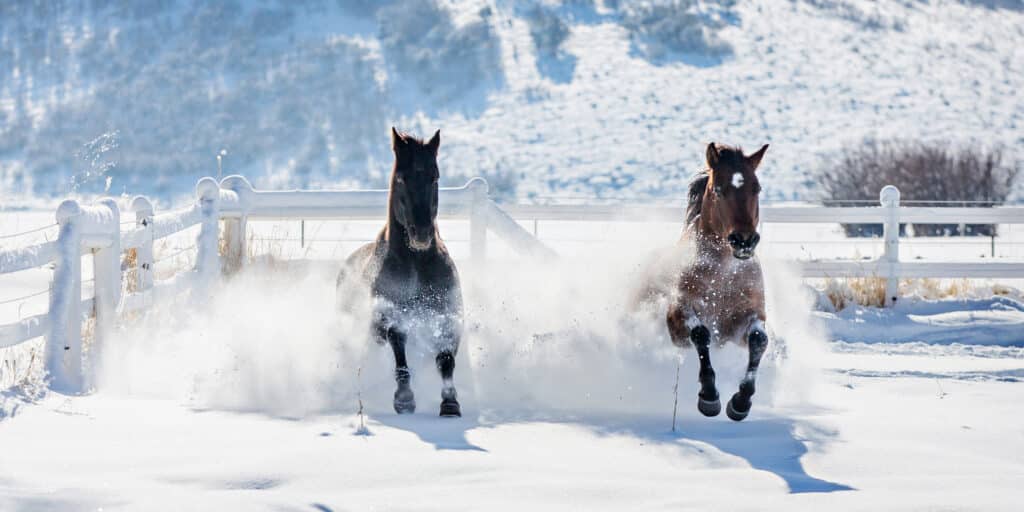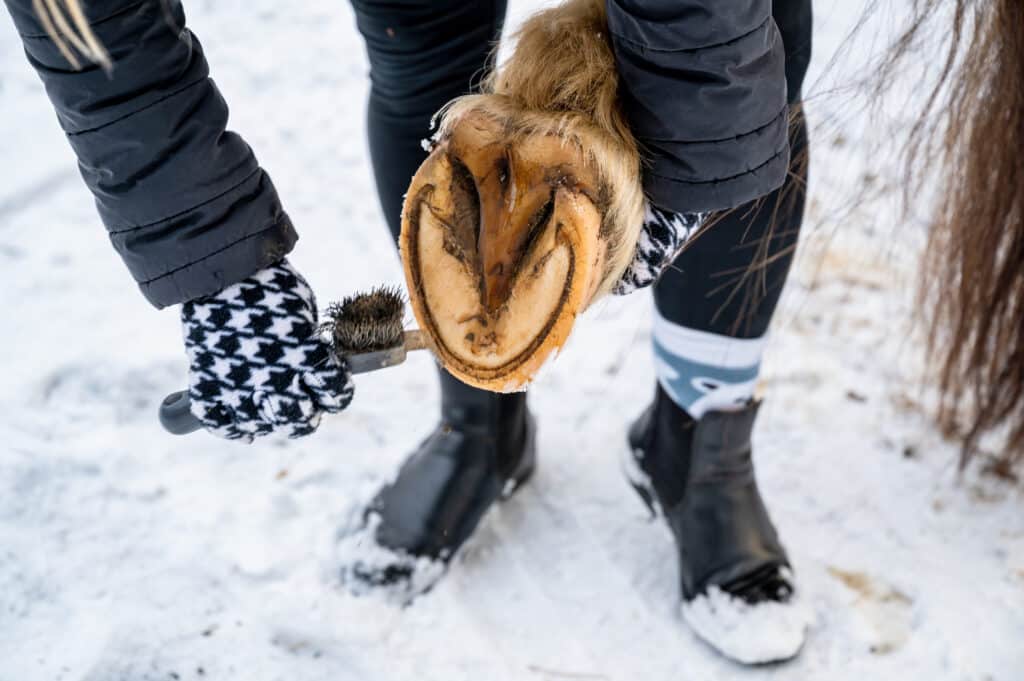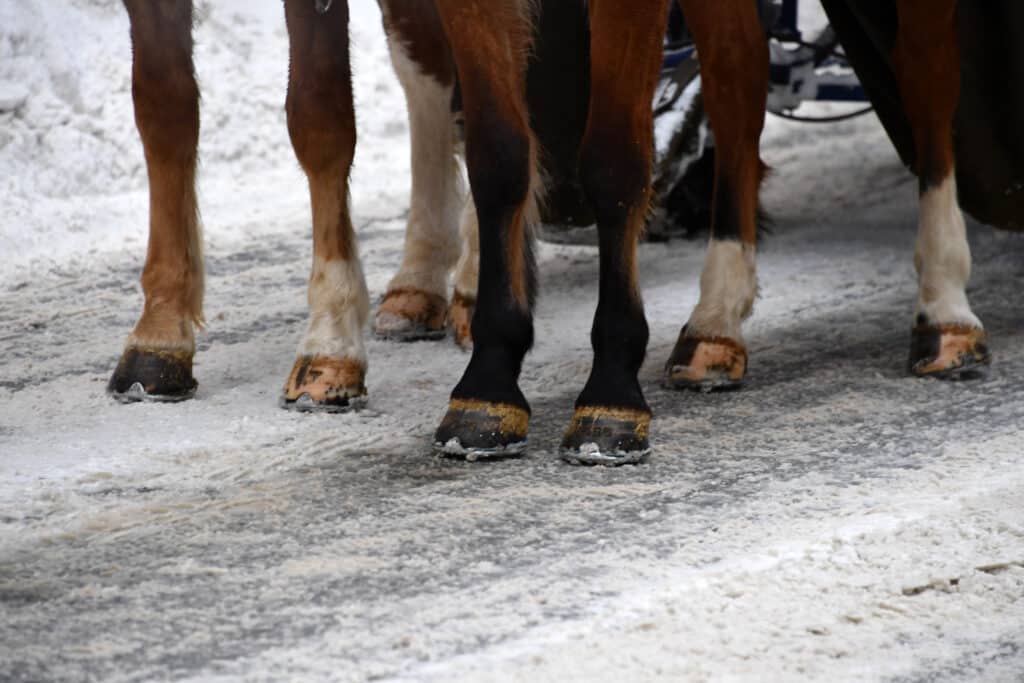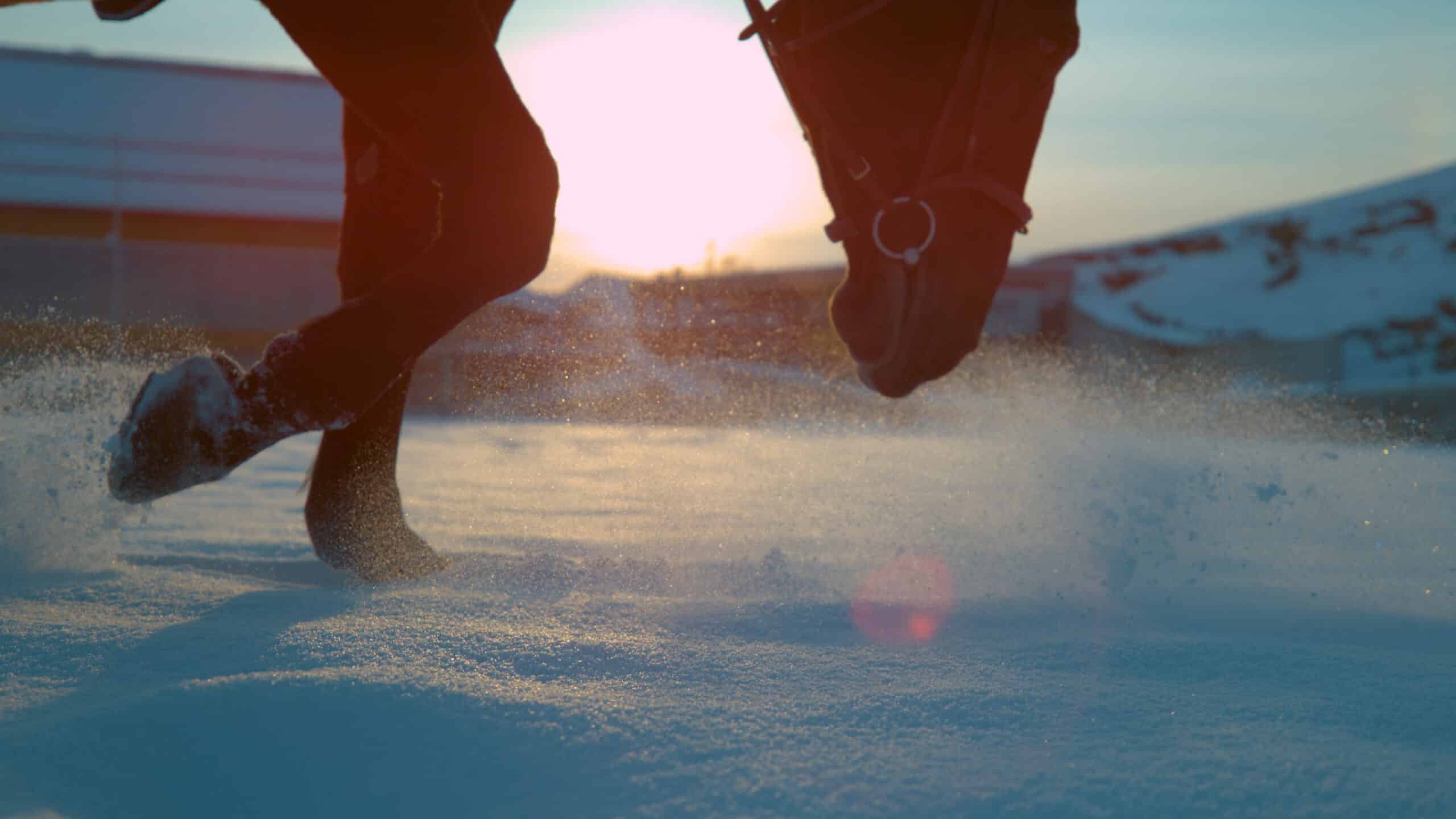7 Essential Tips for Effective Winter Hoof Care
When winter settles in across New England, it brings its fair share of challenges for horse owners – frozen ground, muddy paddocks, icy paths, and long stretches of cold, damp weather. While it’s easy to focus on blanketing, feeding, and barn prep, one area that might get overlooked is hoof health. Proper winter hoof care is one of the most important steps you can take to keep your horse healthy and comfortable through the cold months.
Cold weather can be tough on hooves. Constant changes in temperature and moisture levels can lead to cracks, thrush, and even dangerous slips on icy footing. Here’s how to protect your horse’s hooves this winter with simple, effective routines and a few smart product choices for winter hoof care.

1. Winter Hoof Care: Maintain a Consistent Farrier Schedule
Even though your horse may not be working as hard in winter, regular farrier visits are still essential. Hooves continue to grow throughout the year, and neglecting trims during winter can cause balance issues, chipping, and breakage.
Discuss your horse’s specific needs with your farrier. Some horses benefit from pulling shoes during the winter months if they’re not in heavy work, especially if they’re turned out frequently. Barefoot horses tend to have better traction on snow and ice, and removing shoes can help prevent snowballing under the hoof.
If your horse stays shod, ask your farrier about special traction options such as borium or studs for grip. Snow pads or rim pads can also help prevent snow and ice from packing into the sole, reducing the risk of bruising and slips.
2. Keep Hooves Clean and Dry
Moisture is one of the biggest culprits behind winter hoof problems. Alternating between wet and frozen conditions weakens the hoof wall and can create the perfect environment for bacteria to thrive.
Pick your horse’s hooves daily, especially after turnout. Remove packed snow, mud, and debris from the frog and sole. A simple habit like this can go a long way in preventing thrush, a common bacterial infection that causes a foul smell and black, crumbly tissue around the frog.
If your paddocks are muddy, try to provide dry areas for your horses to stand. Rubber mats, gravel footing, or even old stall shavings can help keep hooves cleaner and drier.

3. Watch for Cracks and Chips
Winter weather can dry out the hoof wall, leading to cracks or splits that worsen over time. Using a hoof conditioner or oil designed for cold weather can help maintain moisture balance without over-softening the hoof.
Products containing natural ingredients like lanolin, beeswax, or pine tar are great for sealing in hydration. Apply conditioner to clean, dry hooves several times a week – especially after long exposure to snow or ice.
If you notice a deep crack forming, don’t ignore it. Contact your farrier for advice before it worsens. A quick fix early on can prevent lameness and more serious issues later in the season.
4. Prevent Ice and Snow Build Up
One of the biggest winter hazards for horses is snow and ice balling up under their hooves. These frozen clumps can make it nearly impossible for your horse to walk safely and can strain tendons or cause slips.
If your horse is barefoot, applying a non-stick hoof product or cooking spray before turnout can help reduce snow build up. For shod horses, snow pads or “popper” pads that flex with the hoof can help push snow out naturally as your horse moves.
Check your horse’s feet regularly after turnout and remove any compacted snow or ice before leading them across slippery areas.

5. Keep Diet and Hydration in Balance
Good winter hoof care starts from the inside out. A well balanced diet rich in biotin, zinc, and amino acids supports strong, resilient hooves year-round. Adding a quality hoof supplement during winter can help offset the effects of dry or frozen conditions.
Hydration is also crucial – dehydrated horses are more prone to poor circulation, which can affect hoof health. Make sure your horse always has access to clean, unfrozen water. Heated buckets or automatic waterers can make this much easier when temperatures drop below freezing.
6. Inspect Daily for Changes
Even small changes in the appearance or smell of your horse’s hooves can signal a problem. During winter hoof care checks, watch for:
- A foul odor or soft, black tissue (symptoms of thrush)
- Cracks or flares in the hoof wall
- Tenderness or reluctance to walk on certain surfaces
- Snow or ice packed into the sole
Catching problems early allows for faster, easier treatment and keeps your horse comfortable through unpredictable winter weather.

7. Create a Safe Winter Turnout Environment
Footing plays a big role in hoof health during the winter. Avoid icy or uneven surfaces when possible and keep turnout areas well-maintained. Regularly breaking up ice patches or adding traction materials like sand or shavings can make a big difference for winter hoof care.
If your horse spends a lot of time outside, ensure they have access to a dry, sheltered area where their hooves can rest and dry out. This simple step helps reduce moisture-related issues and supports overall comfort.
Essential Winter Hoof Care
Caring for your horse’s hooves in winter doesn’t have to be complicated, it just requires consistency and awareness. Regular farrier visits, daily hoof checks, clean turnout areas, and a balanced diet all work together to keep your horse’s feet healthy and strong. With proper winter hoof care, you can help your horse stay safe and comfortable!
From hoof conditioners and thrush treatments to winter blankets and barn essentials, The Trainer’s Loft has everything you need to care for your horse this season. Visit our location in Tilton, New Hampshire or shop online to find trusted products that make winter hoof care easier and more effective. To see our current selection of hoof care products, click here!


